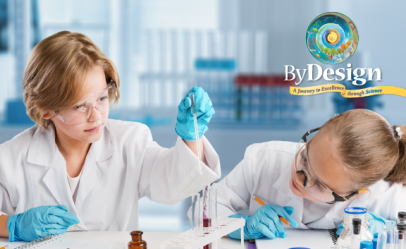 By: Kendall Hunt RPD with contributions from the editorial team
By: Kendall Hunt RPD with contributions from the editorial team
Did you know that the ByDesign Science program (grades 1-8), includes activities for student choice? Students can solve open inquiries and thought-provoking problems using their own ideas and ingenuity. Inquiry labs often take place in groups where student drive their own learning with student-led activities.
It focuses on individual experience allowing every element of the design to invite, engage, instruct, and motivate students (and teachers) to strengthen their relationship with our creator as they continue learning and building their science knowledge.
Inquiry science naturally lends itself to experiments and hands-on activities to engage students to fire up their natural curiosity. However, teachers must ensure that curiosity is the only thing being ignited. Working with chemicals, sharps, and heat in a science lab can be hazardous if handled improperly. It is important that students and teachers share the responsibility of maintaining a safe environment.
A member of the editorial and development team says, “It’s important, to me, that our students and teachers understand that they can be delighted by all things science, maintain their faith, and conduct their inquiry research with safety!”
We’ve taken five basic safety guidelines given to students—the ones that, hopefully, are common sense—and turned them around to focus on what the teacher can do in relation to that theme. We take each topic one step further to discuss elements of lab safety that teachers may not have considered but would do well to remember.
1. Simple standard for students: Read the directions.
Top tip for teachers: Offer demonstrations, not just activity sheets.
Especially for visual learners who need to see something to understand it, a long list of directions on a page might be meaningless. Students may skip them or accidentally omit steps. Remind students to read directions, especially in activities with potentially hazardous materials. But you may want to consider demonstrating part of the activity yourself so that young scientists have an idea of what their experiment is “supposed” to look like.
2. Simple standard for students: Wear your safety goggles.
Top tip for teachers: Remember that goggles aren’t just for chemical activities.
It’s easy to see why goggles are necessary for labs with dangerous chemicals or flames. But goggles also protect your students’ eyes from flying projectiles, such as rubber bands, which often appear in elementary school labs. Set a good example for your students by wearing your goggles throughout the entire activity, even in non-chemical labs.
3. Simple standard for students: Be careful with sharp items.
Top tip for teachers: Precut materials so that students don’t have to handle sharp tools.
Cuts are the most common science classroom injury. There are times when the cutting process is an integral part of the lab activity, but when possible, eliminate the possibility of injury by doing it beforehand. It saves you stress and your students time while reducing material waste if students fail to “measure twice, cut once”.
4. Simple standard for students: Keep your hair and clothes tied back.
Top tip for teachers: Ditch the acrylic nails.
From long hair to flip-flops, there’s a long list of personal grooming no-no’s for the science classroom. But here’s one you may not have considered: acrylic nails, whether store-bought or professionally applied, are extremely flammable. In one study, a woman sustained serious burns to her thumb when her cigarette ignited her acrylic nail, resulting in permanent damage. Moral of the story: make your students aware, especially around homecoming and prom, and remind them to keep their nails short and natural. And, of course, do the same with your own.
5. Simple standard for students: Clean up your workstation.
Top tip for teachers: Allow adequate time for cleanup.
Trying to cram an hour-long experiment into 45-minute class period leaves students scrambling to complete the activities as the late bell rings, with no time for cleanup. That’s when students start rushing … and that’s when accidents happen. It’s absolutely the students’ responsibility to clean up properly, but it’s on you to give them enough time to get it done. Be realistic about what can be completed during one class.
Which of these tips will you implement to create a safer science classroom?
Sources:
https://www.acs.org/content/dam/acsorg/about/governance/committees/chemicalsafety/safetypractices/safety-in-the-elementary-school-science-classroom.pdf
http://static.nsta.org/pdfs/SafetyInTheScienceClassroom.pdf
http://www.elsp.ie/safety/Safety%20in%20the%20Science%20Classroom.pdf
https://www.ncbi.nlm.nih.gov/pmc/articles/PMC5241193/